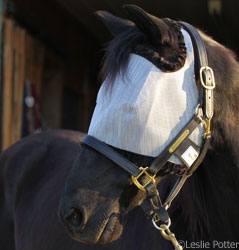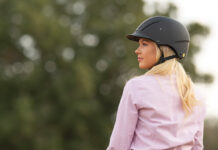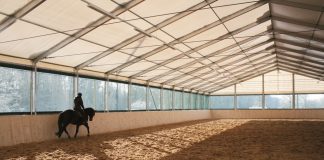 Fly masks offer protection from annoying insects, so horses across the country are outfitted in them during summer’s winged onslaught. But fly masks can sometimes harm your horse if basic application guidelines aren’t followed.
Fly masks offer protection from annoying insects, so horses across the country are outfitted in them during summer’s winged onslaught. But fly masks can sometimes harm your horse if basic application guidelines aren’t followed.
- Fly masks need to be removed at least once a day—twice is better—to check for any problems.
- Remove fly masks at night unless there is a medical reason to keep them on.
- Some fly masks can scratch your horse’s eyes, leading to corneal ulcers, so choose a well-fitting style that features eye darts and is made of a non-abrasive material.
- Properly clean fly masks on a regular basis. Dirt and debris that collect on a fly mask can land in your horse’s eyes; “scurfy” fly masks can also lead to skin disease. Dr. Brendemuehl recommends keeping at least one spare fly mask on hand per horse so that you can regularly launder dirty ones.
- Make sure the fly mask you choose is a good fit for your horse. Pressure points cause irritation and lead to sores. Dr. Brendemuehl recommends fly masks that feature soft linings on areas that touch your horse’s head and face.






very informative, why take the mask off at night? but can they recommend one brand over the rest.
I use a fly mask on my horse in the summer and she is absolutely fine with them. Sometimes she manages to mysteriously slip off her fly mask and then hides it in the paddock. I am going to try to somehow fit it underneath her halter to see if that helps.
I use the “bug eye” mask, so it won’t scratch my horses eyes. It works very well!
I have never used a fly mask, mainly because every horse I have been in charge of hasn’t liked them.
i would guess that leaving a fly mask on at night obstructs their vision even more, since it’s even darker. however, i leave the masks on my mares at night because where I live, the flys bother you late in the dusk and early in the morning as well as all day.
I’ve been using a fly mask on my gelding. Recently, the owner of the barn where he’s boarded put the fly mask on him in the AM. When I got to him in the PM to remove the mask, the entire right side of his face was covered in fly bite welts. Apparently, the owner didn’t do a good job of putting the mask on (they’re always warning me not to put it on “so tight”) and a horse fly had gotten up under the mask and really did a number on him. He reacts to the fly bites anyway, and this was a particularly nasty looking job. Now, I’m a little afraid of using the mask on him again.
Good tips.